Chronosequence of Fuel Loading and Fuel Depth Following Forest Rehabilitation Frill Treatment of Tanoak to Release Douglas-Fir: A Case Study from Northern California
Abstract
1. Introduction
2. Materials and Methods
2.1. Site Description
2.2. Fuel Loading Conversion
3. Results
3.1. Fuel Depth
3.2. Fuel Loading
4. Discussion
5. Conclusions
Author Contributions
Funding
Acknowledgments
Conflicts of Interest
Appendix A
| Duff | Litter | 1-h | 10-h | 100-h | 1000-h sound | 1000-h rotten | Total | |
|---|---|---|---|---|---|---|---|---|
| Year 0 (pre) | 20.66 | 18.93 | 0.65 | 2.72 | 3.20 | 0.00 | 6.40 | 12.97 |
| Year 0 (post) | 16.64 | 19.13 | 1.05 | 3.99 | 11.75 | 12.98 | 2.11 | 31.87 |
| Year 5 | 34.34 | 26.92 | 1.15 | 4.45 | 14.55 | 32.60 | 6.77 | 59.51 |
| Year 11 | 19.23 | 19.53 | 0.46 | 3.20 | 9.41 | 0.00 | 56.20 | 69.26 |
| Year 16 | 13.11 | 10.48 | 0.39 | 2.57 | 6.71 | 4.30 | 8.84 | 22.81 |
References
- Skinner, C.N.; Abbott, C.S.; Fry, D.L.; Stephens, S.L.; Taylor, A.H.; Trouet, V. Human and climatic influences on fire occurrence in California’s North Coast Range, USA. Fire Ecol. 2009, 5, 76–99. [Google Scholar] [CrossRef]
- Agee, J.K. Fire Ecology of Pacific Northwest Forests; Island Press: Washington, DC, USA, 1993. [Google Scholar]
- Sugihara, N.G.; Van Wagtendonk, J.W.; Shaffer, K.E.; Fites-Kaufman, J.; Thode, A.E. Fire in California’s Ecosystems; University of California Press: Berkeley, CA, USA, 2006. [Google Scholar]
- Berrill, J.-P.; Boston, K. Conifer retention and hardwood management affect interplay between harvest volume and carbon storage over 100 years in Douglas-fir/tanoak: A case study. Math. Comp. For. Nat. Res. Sci. 2019, 11, 286–293. [Google Scholar]
- Berrill, J.-P.; Han, H.-S. Carbon, harvest yields, and residues from restoration in a mixed forest on California’s Coast Range. For. Sci. 2017, 63, 128–136. [Google Scholar] [CrossRef]
- Dagley, C.M.; Berrill, J.-P. The Coast Range Dry Forest Restoration Experiment; Unpublished Final Report; California Department of Forestry and Fire Protection as part of the California Climate Investments Program: Sacramento, CA, USA, 2020; 12p. [Google Scholar]
- Sawyer, J.O.; Gray, J.; West, G.J.; Thornburgh, D.A.; Noss, R.F.; Engbeck, J.H., Jr.; Marcot, G.E.; Raymond, R. The Redwood Forest: History, Ecology, and Conservation of the Coast Redwoods; Chapter 2: History of Redwood and Redwood Forests. pp. 7–37; Noss, R.F., Ed.; Island Press: Washington, DC, USA, 2000; 339p. [Google Scholar]
- Berrill, J.-P.; Howe, R.A. Multiaged redwood responds well to partial harvest and herbicide treatments. Can. J. For. Res. 2019, 49, 1425–1433. [Google Scholar] [CrossRef]
- Valachovic, Y.S.; Lee, C.A.; Scanlon, H.; Varner, J.M.; Glebocki, R.; Graham, B.D.; Rizzo, D.M. Sudden oak death-caused changes to surface fuel loading and potential fire behavior in Douglas-fir-tanoak forests. For. Ecol. Manag. 2011, 261, 1973–1986. [Google Scholar] [CrossRef]
- Radosevich, S.R.; Passof, P.C.; Leonard, O.A. Douglas-fir release from tanoak and Pacific madrone competition. Weed Sci. 1976, 24, 144–145. [Google Scholar] [CrossRef]
- Harrington, T.B.; Tappeiner, J.C., II. Growth responses of young Douglas-fir and tanoak 11 years after various levels of hardwood removal and understory suppression in southwestern Oregon, USA. For. Ecol. Manag. 1997, 96, 1–11. [Google Scholar] [CrossRef]
- Harrington, T.B. Long-term effects of tanoak competition on Douglas-fir stand development. Can. J. For. Res. 2009, 39, 765–776. [Google Scholar] [CrossRef]
- Stephens, S.L.; Martin, R.E.; Clinton, N.E. Prehistoric fire area and emissions from California’s forests, woodlands, shrublands, and grasslands. For. Ecol. Manag. 2007, 251, 205–216. [Google Scholar] [CrossRef]
- Minogue, P.J. Introduction to imazapyr herbicide for forest vegetation management in California. Proc. For. Veg. Manag. Conf. 1997, 18, 1–7. [Google Scholar]
- Kuljian, H.; Varner, J.M. The effects of sudden oak death on foliar moisture content and crown fire potential in tanoak. For. Ecol. Manag. 2010, 259, 2103–2110. [Google Scholar] [CrossRef]
- Brown, J.K. Handbook for Inventorying Downed Woody Material; USDA Tech. Rep. INT-I6: Ogden, UT, USA, 1974; 24p. [Google Scholar]
- Agee, J.K.; Skinner, C.N. Basic Principles of Forest Fuel Reduction Treatments. For. Ecol. Manag. 2005, 211, 83–96. [Google Scholar] [CrossRef]
- Zeibig-Kichas, N.E.; Ardis, C.W.; Berrill, J.-P.; King, J.P. Bark thickness equations for mixed-conifer forest type in Klamath and Sierra Nevada Mountains of California. Int. J. For. Res. 2016, 1864039, 1–10. [Google Scholar] [CrossRef]
- Berrill, J.-P.; O’Hara, K.L.; Kichas, N.E. Bark thickness in coast redwood (Sequoia sempervirens (D.Don) Endl.) varies according to tree- and crown size, stand structure, latitude, and genotype. Forests 2020, 11, 637. [Google Scholar] [CrossRef]
- Stephens, S.L.; Moghaddas, J.J.; Edminster, C.; Fiedler, C.E.; Haase, S.; Harrington, M.; Keeley, J.E.; Knapp, E.E.; McIver, J.D.; Metlen, K. Fire Treatment Effects on Vegetation Structure, Fuels, and Potential Fire Severity in Western US Forests. Ecol. Appl. 2009, 19, 305–320. [Google Scholar] [CrossRef]
- Kramer, H.A.; Collins, B.M.; Kelly, M.; Stephens, S.L. Quantifying Ladder Fuels: A New Approach Using LiDAR. Forests 2014, 5, 1432–1453. [Google Scholar] [CrossRef]
- Kramer, H.A.; Collins, B.M.; Lake, F.K.; Jakubowski, M.K.; Stephens, S.L.; Kelly, M. Estimating Ladder Fuels: A New Approach Combining Field Photography with LiDAR. Remote Sens. 2016, 8, 766. [Google Scholar] [CrossRef]
- O’Hara, K.L. Multiaged Silviculture: Managing for Complex. Forest Stand. Structures; Oxford University Press: Oxford, UK, 2014. [Google Scholar]
- Vanderwel, M.C.; Malcolm, J.R.; Smith, S.M. An integrated model for snag and downed woody debris decay class transitions. For. Ecol. Manag. 2006, 234, 48–59. [Google Scholar] [CrossRef]
- Russell, R.E.; Saab, V.A.; Dudley, J.G.; Rotella, J.J. Snag longevity in relation to wildfire and postfire salvage logging. For. Ecol. Manag. 2006, 232, 179–187. [Google Scholar] [CrossRef]
- Raphael, M.G.; Morrison, M.L. Decay and Dynamics of Snags in the Sierra Nevada, California. For. Sci. 1987, 33, 774–783. [Google Scholar]
- Russell, M.B.; Weiskittel, A.R. Assessing and modeling snag survival and decay dynamics for the primary species in the Acadian forest of Maine, USA. For. Ecol. Manag. 2012, 284, 230–240. [Google Scholar] [CrossRef]
- Russell, M.B.; Woodall, C.W.; Fraver, S.; D’Amato, A.W.; Domke, G.M.; Skog, K.E. Residence times and decay rates of downed woody debris biomass/carbon in eastern US forests. Ecosystems 2014, 17, 765–777. [Google Scholar] [CrossRef]
- Zhou, L.; Dai, L.; Gu, H.; Zhong, L. Review on the decomposition and influence factors of coarse woody debris in forest ecosystem. J. For. Res. 2007, 18, 48–54. [Google Scholar] [CrossRef]
- Chiono, L.A.; O’Hara, K.L.; De Lasaux, M.J.; Nader, G.A.; Stephens, S.L. Development of Vegetation and Surface Fuels Following Fire Hazard Reduction Treatment. Forests 2012, 3, 700–722. [Google Scholar] [CrossRef]
- Keane, R.E. Describing wildland surface fuel loading for fire management: A review of approaches, methods and systems. Int. J. Wildland Fire 2013, 22, 51–62. [Google Scholar] [CrossRef]
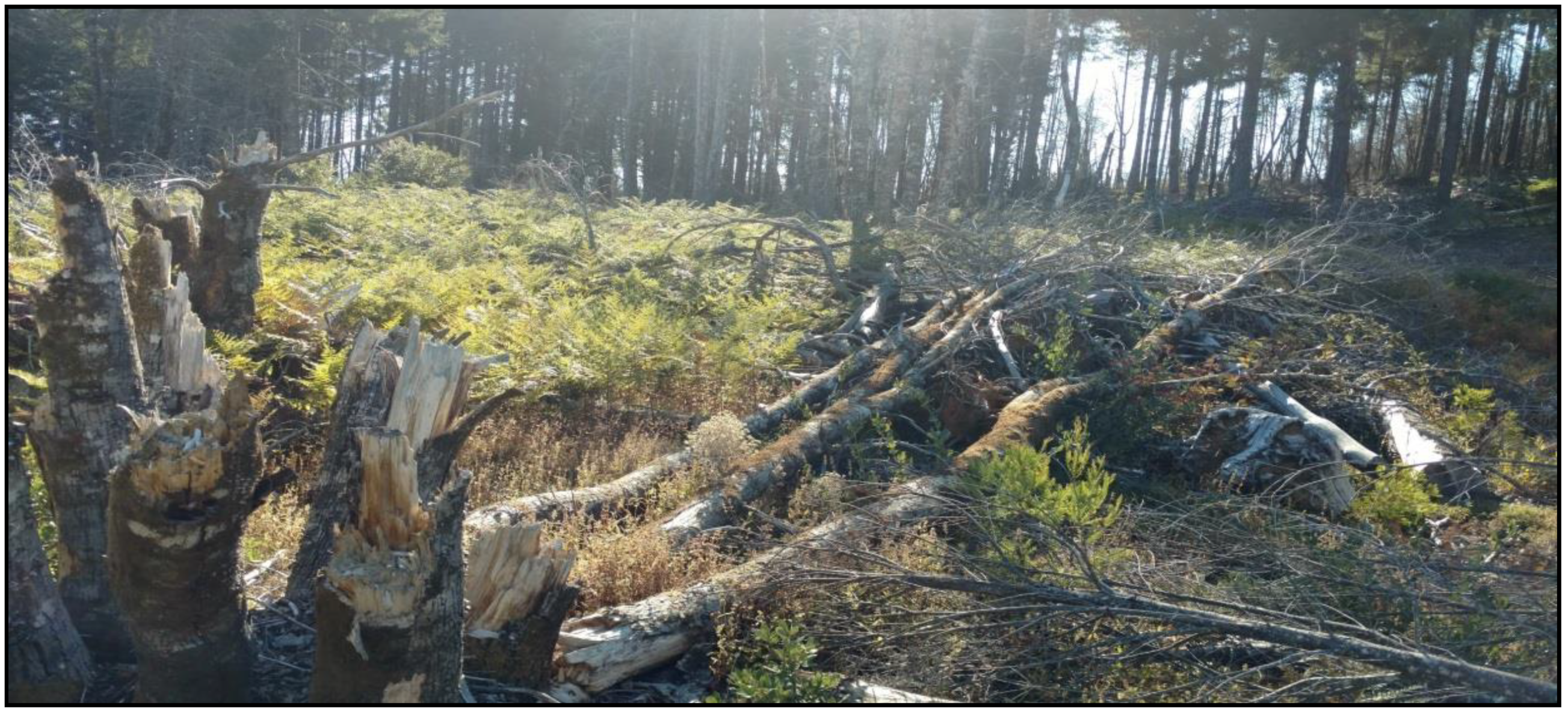
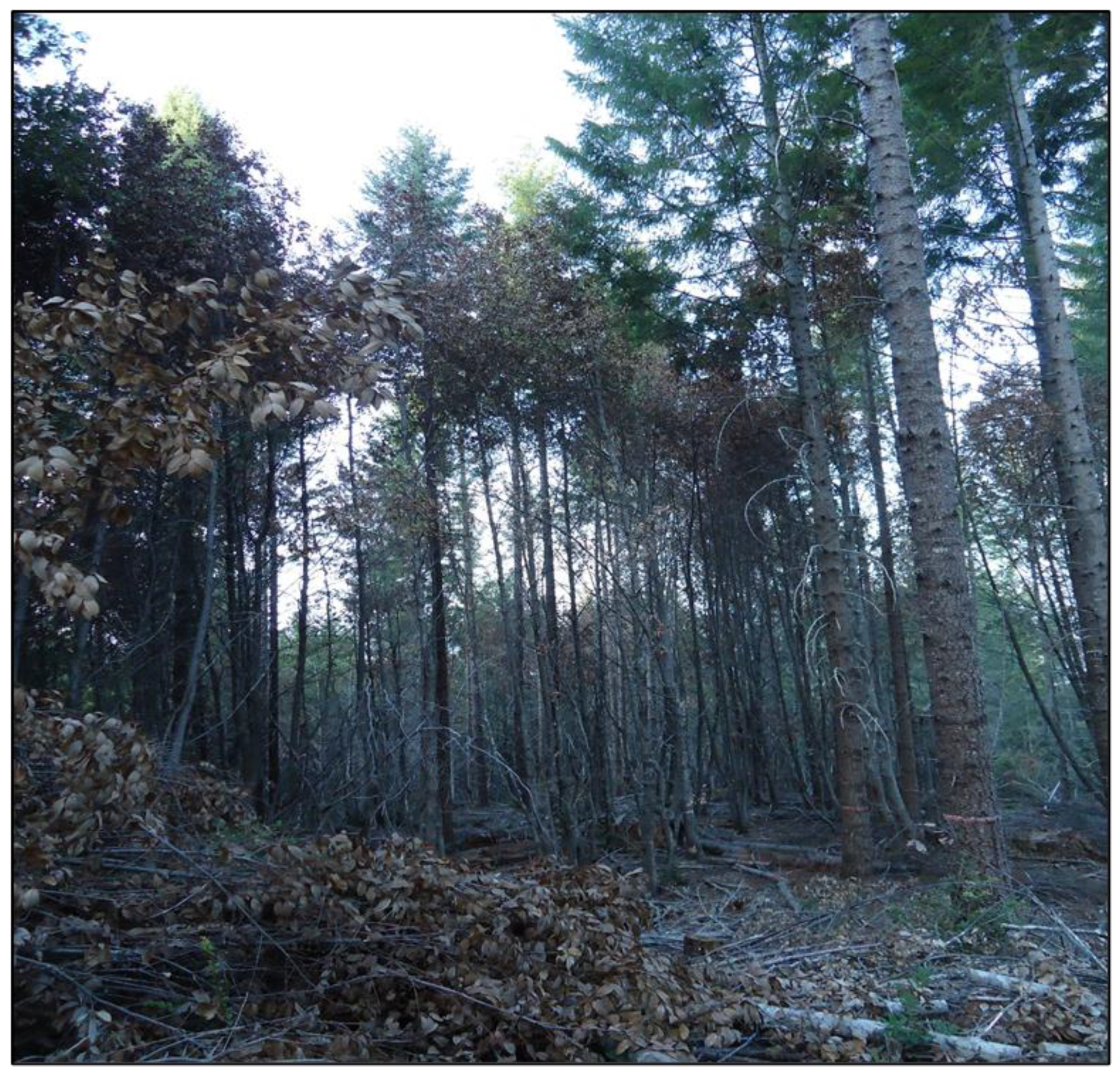
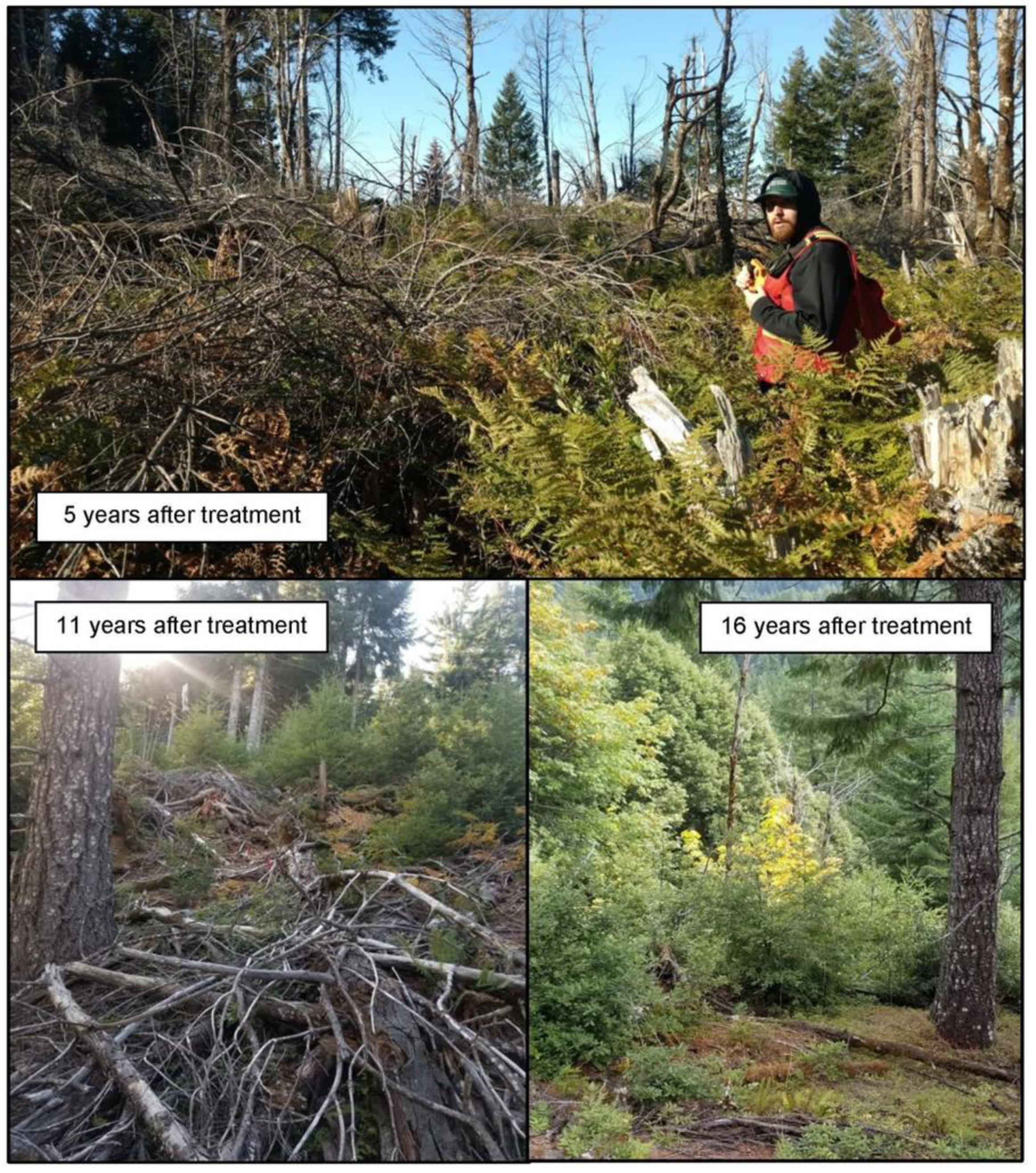
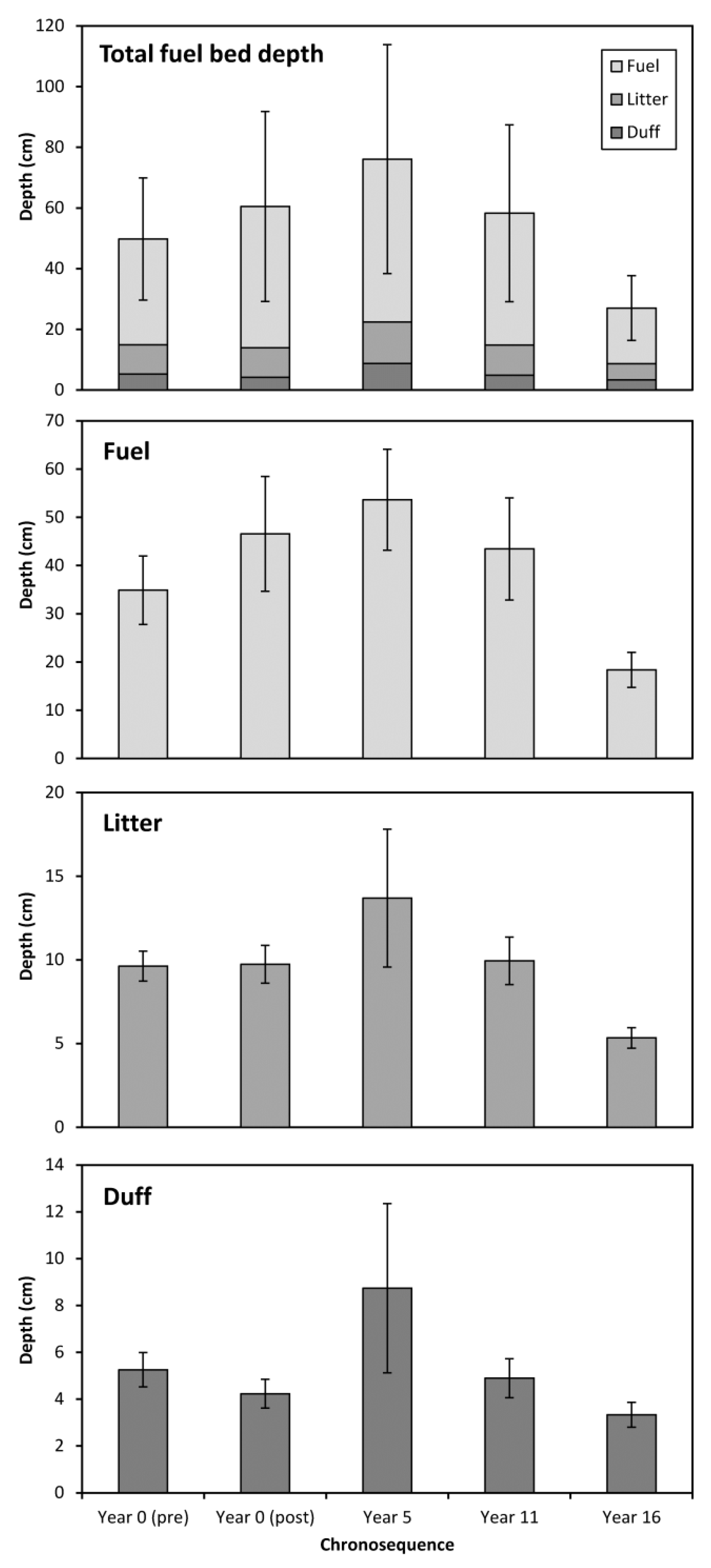
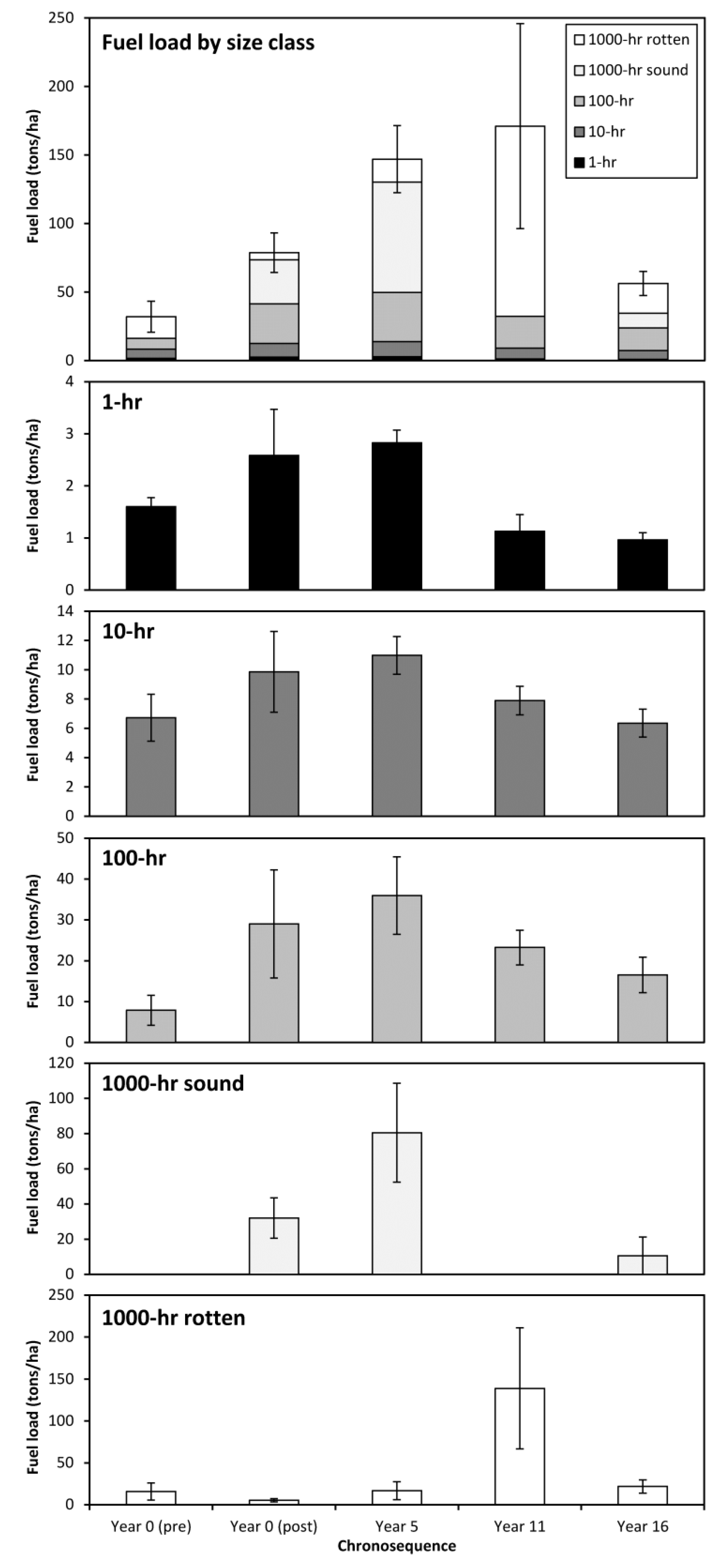
© 2020 by the authors. Licensee MDPI, Basel, Switzerland. This article is an open access article distributed under the terms and conditions of the Creative Commons Attribution (CC BY) license (http://creativecommons.org/licenses/by/4.0/).
Share and Cite
Krieger, R.M.; Wall, B.E.; Kidd, C.W.; Berrill, J.-P. Chronosequence of Fuel Loading and Fuel Depth Following Forest Rehabilitation Frill Treatment of Tanoak to Release Douglas-Fir: A Case Study from Northern California. Forests 2020, 11, 691. https://doi.org/10.3390/f11060691
Krieger RM, Wall BE, Kidd CW, Berrill J-P. Chronosequence of Fuel Loading and Fuel Depth Following Forest Rehabilitation Frill Treatment of Tanoak to Release Douglas-Fir: A Case Study from Northern California. Forests. 2020; 11(6):691. https://doi.org/10.3390/f11060691
Chicago/Turabian StyleKrieger, Raven M., Brian E. Wall, Cody W. Kidd, and John-Pascal Berrill. 2020. "Chronosequence of Fuel Loading and Fuel Depth Following Forest Rehabilitation Frill Treatment of Tanoak to Release Douglas-Fir: A Case Study from Northern California" Forests 11, no. 6: 691. https://doi.org/10.3390/f11060691
APA StyleKrieger, R. M., Wall, B. E., Kidd, C. W., & Berrill, J.-P. (2020). Chronosequence of Fuel Loading and Fuel Depth Following Forest Rehabilitation Frill Treatment of Tanoak to Release Douglas-Fir: A Case Study from Northern California. Forests, 11(6), 691. https://doi.org/10.3390/f11060691





